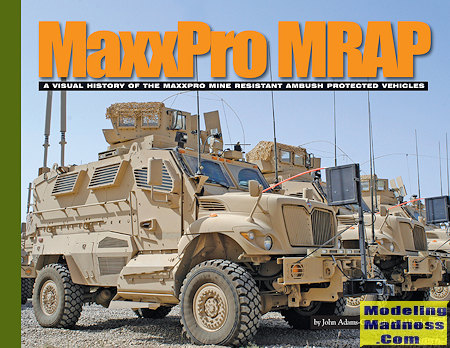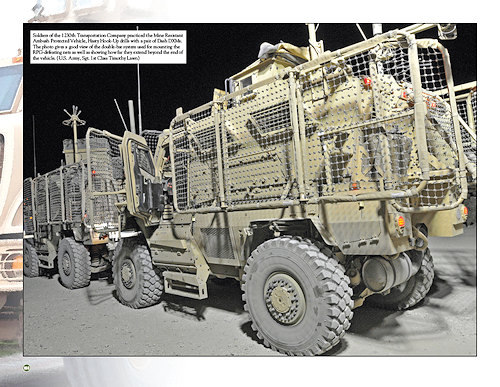Ampersand's MaxxPro MRAP
|
BY: |
David Doyle |
|
PUBLISHER
/PRICE: |
Ampersand
$22.95 |
|
REVIEW BY: |
Scott
Van Aken |
| NOTES: |
120 pages, hardcover, landscape, ISBN 978-1-944367-01-5 |
 For some
reason, the US military does not learn the lessons of previous conflicts very
well, especially if they are not directly involved. This results in a general
flail-ex where folks are blamed and there is a bit of a rush to find a fix.
Meanwhile, soldiers become casualties.
For some
reason, the US military does not learn the lessons of previous conflicts very
well, especially if they are not directly involved. This results in a general
flail-ex where folks are blamed and there is a bit of a rush to find a fix.
Meanwhile, soldiers become casualties.
Such is the case with the wars in
Afghanistan and Iraq. Despite multiple historical precedent about wars in this
part of the world, the US and its coalition went into as if they were fighting a
European war. Then they were surprised when an insurgency erupted and now it
wasn't an army they were facing with modern weapons, but insurgents using
improvised weapons. These were generally deployed as mines and when a vehicle
ran over it or near it: BOOM. Despite an effort to uparmor softskin vehicles,
the flat bottoms of these vehicles simply opened up like a tin can.
What was needed was a vehicle that was
designed with a lot of armor that would shape the blast away from the bottom of
the vehicle. Thus the MRAP or Mine Resistant Ambush Protected vehicle. The
South Africans could have told them this was coming as they had dealt with
pretty much the same thing during the last years of apartheid and developed
vehicles to deal with it. V bottom vehicles with most of the armor on the
bottom.
In the US several companies submitted
plans, some in cooperation with South African corporations who had dealt with
this. This book covers those developed predominantly by Navistar and so the
MaxxPro series was born. These eventually grew to several different types
including a standard, heavier and larger vehicle and a lighter vehicle as well
as a tow truck.
 As part of
the very popular visual history series, Ampersand fully covers the history and
variations of this series of vehicles. It also includes all the various
modifications and updates. There are tons of superb color photos and lots of
close-ups of the many external features. I found it interesting that there were
not any dedicated interior images other than what you could glimpse through open
doors, but perhaps it was too difficult to get those.
As part of
the very popular visual history series, Ampersand fully covers the history and
variations of this series of vehicles. It also includes all the various
modifications and updates. There are tons of superb color photos and lots of
close-ups of the many external features. I found it interesting that there were
not any dedicated interior images other than what you could glimpse through open
doors, but perhaps it was too difficult to get those.
The vast majority of the images are from
the DoD and so you get a considerable number of photos of the vehicles in
country. The history section at the beginning of the book is well done and
provides a great read and something
that gets modeler's interested in reproducing one. Enthusiasts will also find
the book to be very helpful one they will want on their shelves. Highly
recommended.
August 2016
Review copy courtesy
Ampersand Publishing.
Get yours today
at this link.
If you would like your product reviewed fairly and
fairly quickly, please contact
the editor or see other details in the
Note to
Contributors.
 For some
reason, the US military does not learn the lessons of previous conflicts very
well, especially if they are not directly involved. This results in a general
flail-ex where folks are blamed and there is a bit of a rush to find a fix.
Meanwhile, soldiers become casualties.
For some
reason, the US military does not learn the lessons of previous conflicts very
well, especially if they are not directly involved. This results in a general
flail-ex where folks are blamed and there is a bit of a rush to find a fix.
Meanwhile, soldiers become casualties. As part of
the very popular visual history series, Ampersand fully covers the history and
variations of this series of vehicles. It also includes all the various
modifications and updates. There are tons of superb color photos and lots of
close-ups of the many external features. I found it interesting that there were
not any dedicated interior images other than what you could glimpse through open
doors, but perhaps it was too difficult to get those.
As part of
the very popular visual history series, Ampersand fully covers the history and
variations of this series of vehicles. It also includes all the various
modifications and updates. There are tons of superb color photos and lots of
close-ups of the many external features. I found it interesting that there were
not any dedicated interior images other than what you could glimpse through open
doors, but perhaps it was too difficult to get those.